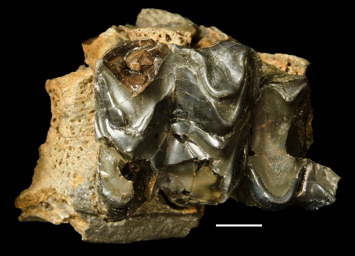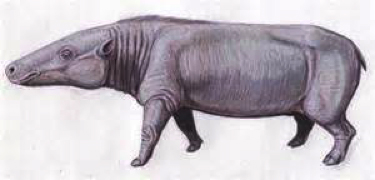By Bruce J. MacFadden

Many of us have had the wonderful opportunity to collect fossils from the Belgrade Quarry, located in eastern North Carolina. This quarry preserves an interesting sequence of mostly Cenozoic marine vertebrate and invertebrate fossils. Although many of the fossils are common, for example the ubiquitous shark teeth and giant oysters, sometimes rare fossils are discovered that are scientifically important. Such is the case with the two associated upper teeth of an anthracothere, an extinct group of mammals that had previously been unknown not just to Belgrade, but to the entire eastern U.S. This fossil was collected by nine-year-old Aidyn Byrd (see photo to the right) from sediment piles excavated during the mining operations at Belgrade. Bradley Dixon (see photo), a resident of eastern North Carolina, was in the field with Aidyn at Belgrade and realized the significance of this find. He then brought it to our attention thanks to Linda McCall, President of the NC Fossil Club. Bradley notes that “we are excited to have discovered such a rare set of molars!”
The fossil depicted here represents an anthracothere, an extinct group of even-toed hoofed mammals (Artiodactyla) related to modern pigs, cattle, deer, sheep, and bison. Anthracotheres are immigrants from Eurasia that invaded North America during the Eocene. This fossil is still being studied to determine its scientific name and interrelationships, but it certainly is one of the youngest (late surviving) members of this group found in North America. It almost certainly came from a distinct unit called the “Belgrade Formation” (Ward, Lawrence, & Blackwelder, 1978) which has otherwise yielded other very rare land mammals, such as extinct horses and rhinos. The structure of the tooth, with its short crown height and complex chewing surface, indicates that it was probably primarily a leaf-eater (browser), and not a grazer like modern bison, for example. Anthracotheres are also interesting because recent evidence indicates that they are related to hippos and ancestral whales.


We borrowed this specimen and our preparator Jason Bourque put it back together. Jeanette Pirlo then scanned the fossil at the micro CT scanning facility at the University of Florida. This resulted in a high-resolution digital file that can be displayed on the computer, or even replicated on a 3D printer (click to view 3D scan of specimen). The original fossil will soon be safely returned to the owner, with our thanks and appreciation for sharing this fossil for scientific research and study.
We are also pleased to report that the 3D fossil gallery is “open for business” on myFOSSIL.org. 3D images can be uploaded (although see the limits to file size) and viewed. This site is primarily intended as a place where 3D images of your fossils (not images of catalogued specimens in research collections) can be archived as digital files. The link to the myFOSSIL 3D gallery is: https://www.myfossil.org/ac-media/
References
Ward, L., D. R. Lawrence, and B. W. Blackwelder. 1978. Stratigraphic revision of the middle Eocene, Oligocene, and Lower Miocene—Atlantic Coastal Plain of North Carolina. Geological Survey Bulletin 1457-F. Available for free on-line at: https://pubs.usgs.gov/bul/1457f/report.pdf